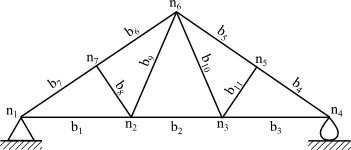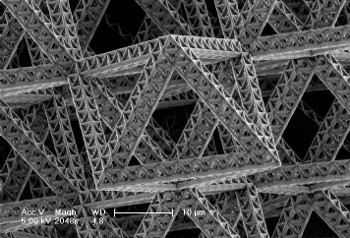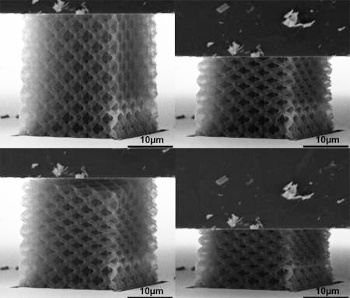Non-Brittle Ceramic Structures
November 21, 2014
A principal difference between
triangles and
quadrilaterals, aside from the obvious difference that triangles have three sides and quadrilaterals have four, is that a collection of three lengths (the sum of the lengths of two of which necessarily longer than the third) will assemble to a triangle with only one set of
angles. As a quadrilateral example, a set of four equal length sides can be assembled into a
square having four
right angles, or a
rhombus having two
acute, and two
obtuse, angles.

Three equal sides will assemble into only one triangle, but four equal sides can assemble into quadrilaterals of various angles, such as a square (center) and a rhombus (right). The transition from a square to a rhombus is often used as an example of shear. (Inkscape.)
You don't need to be a
mechanical engineer to realize that triangles add
dimensional stability to structures. In 1839,
Camille Polonceau, a French
railway engineer, invented the Polonceau
truss, as shown in the figure. This truss is a common element of
roof construction. For this achievement, his name is engraved among the
72 names on the
Eiffel Tower. To realize the importance of this, we need only scan the list of names to find
Cauchy,
Coriolis,
Coulomb,
Gay-Lussac,
Fourier,
Lagrange,
Laplace, and
Lavoisier.

The power of the triangle. A Polonceau truss.
(Via Wikimedia Commons.)
As I wrote in a
previous article (Strong Nano Trusses, September 25, 2013),
scientists at the
California Institute of Technology (Pasadena, California) and the
Jet Propulsion Laboratory (Pasadena, California) created
nanoscale truss-like structures of
titanium nitride on
polymer templates created by
two-photon lithography.[1-2]
When the polymer was subsequently removed, the 75
nanometer wall thickness struts withstood a
compressive strength of 1.75
GPa without failure, even after many
deformation cycles.[1-2] This is remarkable, since the structures were more than 85% air.[2] The Caltech team has continued research on such structures, producing the
alumina-coated structure shown in the
micrograph earlier this year.[3]

Detail of a nano-truss structure.
The scale bar is 10 micrometers.
(L. Meza, L. Montemayor,
N. Clarke, J. Greer / Caltech.)[3)]
With a proper truss design, intrinsically
brittle materials, such as alumina, can be fabricated into deformable structures that won't shatter when
stressed. Instead, they show
elastic behavior over a wide range of applied stress.[3] Says
Julia R. Greer,
professor of
materials science and mechanics at Caltech and
project leader,
"Having full control over the architecture gives us the ability to tune material properties to what was previously unattainable with conventional monolithic materials or with foams... For example, we can decouple strength from density and make materials that are both strong (and tough) as well as extremely lightweight. These structures can contain nearly 99 percent air yet can also be as strong as steel. Designing them into fractals allows us to incorporate hierarchical design into material architecture, which promises to have further beneficial properties."[3]
The Caltech team has continued to improve their materials, now fabricating alumina nanolattices that are 99.9% air and capable of reversible
compressive deformations of 50%.[4-5] These structures were fabricated by the same techniques as for the previous materials; that is, two-photon lithography using
focused lasers to form a polymer base,
atomic layer deposition of the alumina, and
oxygen plasma etching to remove the polymer.
When the
ratio of the wall thickness, which was adjusted between 5-60 nanometers, to the
beam radius is small enough, the nanobeams comprising the structure can be compressed without breaking. When the compressive forces are removed, nearly all the original shape is recovered.[4]

Compression and recovery.
In this sequence, starting from the upper left and going clockwise, an alumina nanolattice is compressed by more than 50%, and it recovers most of its shape when the compressive stress is removed.
(Lucas Meza/Caltech.)
Alumina wall thickness of 10 nanometers for tubes of about a micrometer diameter produced material that suppressed brittle fracture. Instead, there was elastic shell
buckling and a
ductile-like deformation.[4-5] Good recovery of shape resulted even after 85% compression. It's
conjectured that at the 10 nanometer wall thickness, there are few
flaws and their number are small, so the structure is less likely to fail.[5] Says Greer,
"Ceramics have always been thought to be heavy and brittle... We're showing that in fact, they don't have to be either. This very clearly demonstrates that if you use the concept of the nanoscale to create structures and then use those nanostructures like Lego to construct larger materials, you can obtain nearly any set of properties you want. You can create materials by design."[5]
One interesting application for such a strong, lightweight material would be a
gas-free
balloon, just an
evacuated shell that would
float in air. It might also be possible to build a
biocompatible scaffold that would be
infiltrated by
cells for
bone replacement.[5] This
research was funded by the
Defense Advanced Research Projects Agency. Greer is on the
board of directors of the
Kavli Nanoscience Institute at Caltech.[5]
References:
- Dongchan Jang, Lucas R. Meza, Frank Greer and Julia R. Greer, "Fabrication and deformation of three-dimensional hollow ceramic nanostructures," Nature Materials, vol. 12 (September 1, 2013), pp. 893-898, doi:10.1038/nmat3738.
- Kimm Fesenmaier, "Made-to-Order Materials - Caltech engineers focus on the nano to create strong, lightweight materials," California Institute of Technology Press Release, September 5, 2013.
- Kimm Fesenmaier, "Miniature Truss Work," California Institute of Technology Press Release, May, 23, 2014.
- Lucas R. Meza, Satyajit Das, and Julia R. Greer, "Strong, lightweight, and recoverable three-dimensional ceramic nanolattices," Science, vol. 345, no. 6202 (September 12, 2014), pp. 1322-1326, DOI: 10.1126/science.1255908.
- Kimm Fesenmaier, "Ceramics Don't Have To Be Brittle-Caltech Materials Scientists Are Creating Materials By Design," California Institute of Technology Press Release, September 11, 2014.
Permanent Link to this article
Linked Keywords: Triangle; quadrilateral; angle; square; right angle; rhombus; acute; obtuse; rhombus; shear stress; Inkscape; mechanical engineering; mechanical engineer; buckling; dimensional stability; Camille Polonceau; railway engineer; truss; roof; construction; List of the 72 names on the Eiffel Tower; Eiffel Tower; Augustin-Louis Cauchy; Gaspard-Gustave Coriolis; Charles-Augustin de Coulomb; Joseph Louis Gay-Lussac; Joseph Fourier; Joseph-Louis Lagrange; Pierre-Simon Laplace; Antoine Lavoisier; Wikimedia Commons; scientist; California Institute of Technology (Pasadena, California); Jet Propulsion Laboratory (Pasadena, California); nanoscopic scale; nanoscale; truss; titanium nitride; polymer; pattern; template; multiphoton lithography; two-photon lithography; nanometer; compressive strength; pascal; GPa; deformation; aluminium oxide; alumina; micrograph; micrometer; brittleness; brittle; material; stress; elasticity; elastic; Julia R. Greer; professor; materials science and mechanics; project leader; strength of materials; strong; toughness; tough; atmosphere of Earth; air; steel; fractal; hierarchy; hierarchical; compression; compressive; focus; laser; atomic layer deposition; oxygen; plasma etching; ratio; beam; radius; clockwise; aluminium oxide; alumina; latticework; nanolattice; compressed; Lucas Meza; buckling; ductility; ductile; conjecture; bulk defect; flaw; ceramics; Lego; gas; balloon; vacuum; evacuate; buoyancy; float in air; biocompatibility; biocompatible; scaffold; infiltration; infiltrate; cell; bone; research; DARPA; Defense Advanced Research Projects Agency; board of directors; Kavli Nanoscience Institute.